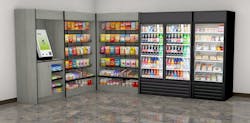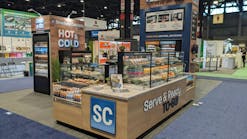While micro markets across the country share certain traits, they also retain individual design. Branding, color use, layout, product placement, size and other components vary. Customers’ preferences and space constraints play a major role in design.
Operators need to consider what will work best for each location on their route, especially now that many customers are reopening facilities amid the coronavirus pandemic, as safety is a top concern. Micro markets may serve a key role in the “new normal,” with design decisions impacting the movement of micro market users.
Automatic Merchandiser asked micro market design suppliers to detail the trends they’ve identified over the past year, both during the epidemic and in an overall view.
Freestanding fixtures, nano markets trending
Access to reliable, safe micro market fixtures that provide options for redesign is key for the convenience services industry. Micro market design suppliers have seen trends toward smaller markets that are easily installed.
“We have seen a rise of demand in our line of freestanding fixtures,” said Bear Wegener, president of Axis Designs, Inc. “Operators are capitalizing on the ease of installing a fixture that arrives fully assembled. Operators are seeing that assembling a panel system that arrives knocked down is cumbersome and time consuming.”
Sandra Faulkenberry, sales manager at All State Manufacturing, works primarily with small operators. She said that customers’ desire for easy assembly and durability has been consistent since last year.
“Operators are looking for the most bang for their buck,” Faulkenberry said. “Is this going to hold up? Do I need to change anything or is it ready as is? End use customers want to be able to get in and get out as quickly as possible with the least amount of hassle.”
Sam Arrington, owner of Genesis Décor, said that micro markets designed to serve smaller populations is a potential area of growth for operators.
“Although there are still large locations out there, the easy fruit has been picked in many areas,” he said. “A lot of operators are looking for more nano market offerings.”
Working with customers
Micro market operators must work within constraints between investment budget from the location, their customer’s desires and the amount of space available, all of which impact design.
Kyle Reifert, president of FrameWorks Displays, said micro market customers’ main interest is in what micro markets have to offer in terms of pricing and inventory, along with what they look like.
“We haven’t heard much from the end users about the design of markets, but rather how much they love the market concept,” Reifert said. “They do like a nice, fine-looking market, but the experience in the break room amounts to a small amount of time in their overall day. They are looking for a well-stocked market with good products, good selection and reasonable pricing. A reliable POS [point of sale] system is also critical.”
Customers’ top concerns are keeping employees happy and minimizing costs and disruption from micro market installations.
“Going forward, operators should be more cost conscious, both for their sake and the location’s,” Reifert added, noting that he anticipates total remodels of break rooms to decrease until businesses have more cash at their disposal. Branding is another component of micro market design that customers weigh in on.
Arrington identifies three profiles of customers: those who want markets to share a company’s branding, those who simply want a shared overall look and those who do not want their company tied to the market due to liability concerns.
“The third type of customer is more pragmatic and is only concerned about the function. Of course, we do everything we can to address all three,” Arrington said.
Shopping for a design supplier
Quality design from reliable suppliers can help micro market operators gain and retain customers. To build credibility with accounts, operators should invest in micro market fixture and design suppliers that produce quality mockups of micro market layouts and designs, Wegener said. He recommended operators ask what software a design supplier uses and ask to see examples of design mockups.
“Often, we find the renderings we provide to be the most effective sales tool out there,” Arrington added. Reifert urged operators to consider the amount of industry experience each supplier has while considering whom to work with.
“Operators should look for suppliers who have operated markets and understand the needs of a market,” Reifert said. “Their supplier should be easy to access and have a willingness to work with finding a layout that provides maximum pack out with a minimum footprint. Space is valuable.”
The impact of the coronavirus
Steve Orlando, Fixturelite co-founder, said he has seen the coronavirus pandemic shift the purpose of micro markets from a matter of convenience and keeping employees productive to safely providing them meals onsite to avoid the risk of going to a public place. Micro markets, which can provide packaged, prepared and fresh foods, may even replace many workplace cafeterias, said Troy Geis, CEO of Fixturelite.
In order to ensure employees feel safe, employers might decide to stagger shifts and breaks or limit the number of people in the office, Orlando said. He has also seen an increase in calls from large companies to convert cafeterias to micro markets. Customers may also want micro market operators to be able to quickly and efficiently adjust the position of fixtures at the location.
“Up until the concerns from the virus, the major change was driven by the operators,” Arrington said. “More and more, [customers] are requesting systems that allow for expansion, contraction, and [the] relocation of their market cabinets and décor. They want the flexibility to adjust as conditions change without losing their investment.”
Reifert said operators are seeking practical, cost-effective – yet still high-quality – ways to service locations. He also said these trends are likely to persist through the reopening of locations. He said the FrameWorks merchandisers were designed with these factors in mind.
“We don’t like to think it, but as the economy starts to reopen, there will be markets that close and new ones that pop up,” Reifert said. “Operators will look for equipment that can stand a move to a new location and still be in top condition. Along with that, they will want the ability to open markets quickly.”
Keeping the space clean
Sanitization in the micro market is also key. Regular cleaning of fixtures, equipment and product packaging, and making disinfectant wipe dispensers available is critical, Wegener said. He added that the industry may see additional standards or special regulations.
Arrington remarked that operators’ customers have varied in their responses to the pandemic when it comes to micro markets.
“Just as we see a wide divergence in concern and response to the virus among the public, there are the same differences in concern among the location managements,” he said. “Some are asking for markets to be separated out for social distancing, some want to break them into smaller markets and some have no concerns at all. This is continuing to evolve.”
Arrington said micro markets need to exude a sense of safety, which benefits from a look of quality and regular maintenance.
“We could build the most expensive, amazing décor in the world,” Arrington said. “But if you do not keep it clean and well stocked, then you are wasting your money with us. Our cabinets cannot fix poor route service. So, to be totally frank, if you only have the money to spend on one or the other, hire good route people and make sure cleanliness is a top priority. Our décor can definitely enhance sales in a well-kept market, but otherwise you are wasting money.”
Reifert anticipates that customers might want break rooms scaled down as workplaces may not be operating at full capacity.
“Size, more than design, is what I think will change, along with whatever it takes to be able to enhance cleanliness, because that’s on everybody’s mind, probably from now on,” he said.
Orlando recommended operators use fixtures that clearly indicate cleanliness.
“You want surfaces that are easy to clean, and you want surfaces that show their cleanliness so no one is left guessing as to whether they’ve been attended to or not,” Orlando said. “We can convey a clean environment by how we manufacture our products, how we design a market and how we think about traffic flow within the market space.”
Refreshing markets
Designers hold different views on the value of market redesign. Reifert said that product reset is more important than an overhaul of the market’s overall design.
“A market does not need to be totally refreshed as much as a regular retail outlet, as it is serving a captive market,” he said. “A product reset, however, draws eyes to new areas in the market and also indicates an operator’s interest in providing good service to an account. It also shows the location that you’re taking care of them and you’re interested.”
Arrington said the requisite cycle of updating markets depends on the nature of an operator’s competition and customers.
“From a supplier standpoint, I would like to say every six months,” Arrington remarked, noting that the need to update markets depends on a variety of factors. “If I must choose a number, I will say at least once every five years, and depending on your specific competition or the restlessness of your customer, it could be more often.”
Wegener, on the other hand, recommends operators commit to keeping customers interested with frequent micro market design updates.
“Long-term success is dependent upon keeping the customer interested and the space refreshed,” Wegener remarked. “Operators are constantly under pressure to win new business, improve account retention and negotiate longer contracts. Astute operators will determine what is or is not performing and adjust their layout accordingly.”
“Existing markets may need to be remodeled so that they are more complementary to traffic flow and more thoughtful about the overall design. The overall layout may need to be reconsidered to accommodate for social distancing when shoppers shop,” Orlando added.
Geis said that operators should focus on continuously improving the customer’s experience while keeping service consistent and outstanding.
“Part of maintaining that experience is continuous refresh and improvement,” Geis said. “That doesn’t mean you change your market from being green to red and say, ‘hey, we upgraded our market.’ Refreshed shopping environments today reflect changes based upon things that you found have caused the consumers friction.”
Good layout means good flow
“Friction” in micro markets is the opposite of what operators want, Orlando and Geis explained. Geis said Fixturelite strives to incorporate a particular flow of traffic through layout decisions, lighting and product merchandising solutions to encourage people to move on a predesignated path.
Orlando said a recent micro market redesign increased the operator’s revenue since they were able to ease the flow of traffic through the break room. They used heat mapping to determine the foot traffic habits of the consumers when moving toward coffee stations and packaged foods. Shorter lines mean less friction, and equate to a better consumer experience, Geis explained.
“The traffic flow became so much more efficient that the sales increased,” Orlando said. “There was more frequency to the space because it was a more efficient and welcoming space that made more sense and was better organized.”
Geis said the importance of a frictionless experience is the biggest difference between 2019 and 2020. He said that Gen Z, which is increasingly dominating the workplace, is driving this change.
“We want to take the customer on a journey through the market,” Geis said. “We want it to be consistently frictionless and just happen with ease.”
Arrington said that operators need to consider multiple factors when installing a micro market in order to maximize its utility. Those include assessing the number of employees at a location and the length of the breaks they are allowed. This helps manage congestion at high traffic areas such as the POS and coffee brewers. How frequently the site will receive service, including cleaning, should also be considered.
Do-it-yourself
While many micro market operators decide to work with suppliers, others choose to develop their own micro market concepts.
“We are happy to work with both,” Arrington said. “Those that would like assistance, we can work to refine their graphic ideas, perhaps adjust a cabinet to meet their specific needs or just give advice through their design process.”
Reifert recommended that operators keep design simple. “Small operators should not be overwhelmed with the design aspect and not overthink it,” Reifert said. “You need a dry goods display, cooler and sometimes freezer space, sometimes a coffee option and a payment system. We’d love to explain how simple the process can be.”
Wegener remarked that operators know their accounts best but offered simple advice on planograms. “Generally, we find it best to group refrigerated products separately from dry merchandise,” Wegener said. “Bottled soda and refrigerated food may be on one end while snacks, sundries and coffee service are grouped on another end.”
Wegener recommended that operators doing their own design dedicate adequate resources for realistic presentations. “Unrealistic designs are distracting, and operators run a risk of making themselves look bad,” he said. “A good design will be generated from a quality software with a dedicated experienced designer.”
Orlando encourages operators to truly listen to their customers to understand their needs.
“We often find that micro market operators go in thinking that they have the answers, without asking the customer. Your answers are with your customers,” Orlando advised. “Having a partner who can design and build a micro market or has several different product lines that are interchangeable — and it’s not a one-trick pony or one size fits all — is really the secret to success in providing your customer with what they want. And it should be built around their feedback. If they don’t know what they want and you are guessing, then you need a partner who understands the retail environment and the consumer mindset, which is where we have focused our expertise.”

Mary Stroka | Associate Editor
Mary joined the AM/VMW team in January 2019 as Associate Editor. Her love of animals extends to her snack habits, as she frequently chooses animal crackers when they are available. You can reach her via email at [email protected] or at (920) 234-8145.








